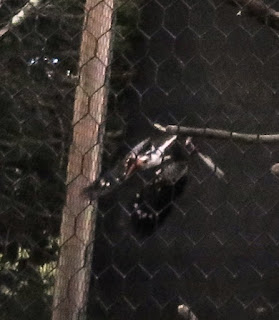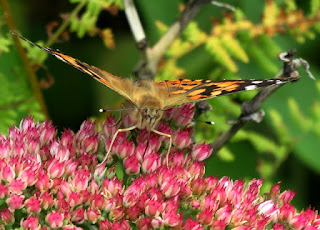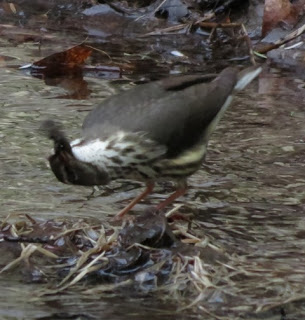Good Day, All! All seven of the monarch butterfly caterpillars have disappeared overnight, perhaps due to same as the half dozen in the back forty; no sign of chrysalis thingies this time. BUT, I had fun with a Painted Lady Butterfly. I hope you enjoy the closeups of its eyes and stuff but, too, there's a lesson to be had that it turns its back on lifeless resources and goes from one feast to another - and isn't life full of them? Scope 'em out...
Meanwhile, several chipmunks (including our Stonewall from last year) are cozying up to us (and the seed tin) of late, comfortable enough to turn their backs on us for a nice long draw from the brook.
The large set of red squirrels have all but disappeared; this one having been victorious, albeit a little muddy around the beak, for having found great pine cones to stash (I'd tell you where along that sharp edge of the brookbank's corner under the old muddy stump, but he swore me to secrecy - would YOU want to betray a face like this? I think NOT!)
The chipmunks have done much barking about aerial predators, mostly having to do with the marsh hawk (larger) that'll swoop along the brook, but also (now) an immature sharp-shinned hawk who easily flops about tree limbs like the robins and blue jays, just pretending to be 'part of the gang' since he's similar size.
But, no, when the chipmunks are barking AND the robins are giving sharp scolds, all telling the threat "WE see you! Move along and leave us be!", they give up and do. I've even seen an eagle chased off by first a crow then a little pair of kingbirds. I guess few critters stay alive better than heeding warnings of neighbors, joining them, and having a little sense of one's worth.
Take Tiberius, for instance. He owns the road as much as he dares, knows which engines are 'friendly' enough they'll slow and yield to him (but moving in a half crouch ready to spring out of harm's way).
Teddy, on the other hand, seems to prefer the fuller living method of avoiding feeling like a fool and burning more calories in a half crouch by owning the stone walls which line this back road. But who's to say which cat is wiser?
And is their purpose to, truly, be compared with each other, as if there's somehow a 'right' or 'wrong' way to be a cat? I don't think I'd make a good judge, so I'll recuse myself on this one.
PS Here's a new-to-me fuzzy caterpillar; guess it belongs to a Brown-Hooded Owlet Moth which - yes - is as fuzzy and brown/gray mottled on its wings as the name suggests:
But if you think it's something different, please be sure to sing out. Far be it from me to ever be incorrect about anything! ;)
Toodles!
Gwyn (aka "Lark")























































